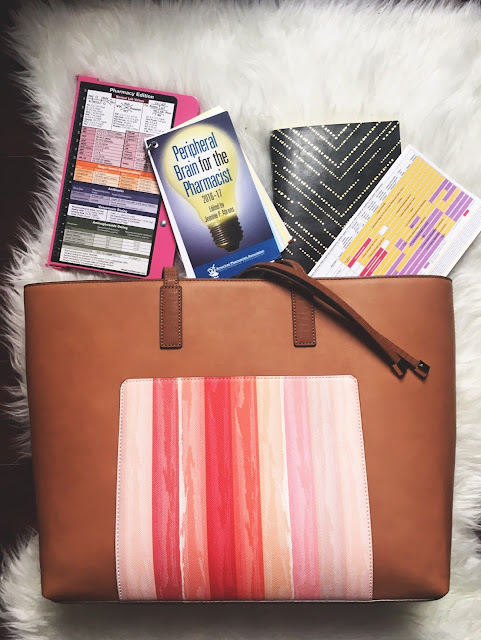What Is In My APPE Bag?
So my first week at my first ever APPE is DONE, and I've learned a ton about transplant already. My first site is Einstein Medical Center's transplant pharmacy rotation inpatient and i'm loving it. I'm definitely kept busy, but it is so awesome to see how valuable pharmacists are in their interprofessional team. What does interprofessional mean? It means we work on a team consisting of many types of healthcare providers (doctors, RNs, PAs, PT, OT, etc.), working together to give our patient the best, dynamic, and safest care. I'm a firm believer that it takes a village to help people through tough conditions, and transplant is definitely one of those conditions. Outside the team, the patients I have seen this past week are so appreciative, and its awesome to see how much they trust my preceptor. I'll do a more comprehensive post on transplant when I have a minute to catch my breath, but I figured I'd give some insight to what I carry with me on my typical APPE day.
The bag doesn't come with me on rounds or to the floor, but its massive and holds everything I need for the day. It was a total steal, $10 at DSW with a bunch of coupons I had, but currently/without coupons it is on sale for $30! I honestly was going to splurge and grab a giant Kate Spade tote but I'm so happy I went with this one. It's cute, it's big, and it's not heavy on my shoulders even when it's packed full of stuff.
Besides carrying a bunch of papers, pens and snacks in my white coat pockets, I carry these items! Anyone in any healthcare field will tell you to always always carry a notebook. I carry two, one of which is not pictured. One is to take notes while on rounds, my other notebook (pictured) is a reference notebook. My last IPPE was at Hahnemann in their cardiology/heart transplant rotation and my preceptor there gave the advice to make a notebook for each APPE filled with tidbits of information I've learned. I decided to try it for her IPPE and ended up really loving it. This notebook is filled with descriptions of disease states I've learned along the way, drug information questions I've had to answer, and diagrams of organ functions (kidney, heart, etc.). It's extremely helpful as a reference for when I need a quick reminder of small details I may have forgotten.
I also carry one of these handy CDC immunization schedules with me. Vaccines are very important to my patients but they can also be very dangerous to transplant patients. My patients cannot receive live vaccinations. Live vaccines consistent of the actual virus toned down so they don't have infective potential in our non-immunosuppressed individuals. Transplant patients are immunosuppressed, meaning they don't have an active immune system, and any sort of virus introduction could have horrible consequences for them. We suppress the immune system of these patients to avoid our patient's immune systems from attacking their new organ. This unfortunately also leaves them susceptible to other infections like ones that the shingles vaccine, a live vaccine, could introduce to them. Instead we suggest that they receive all inactivated vaccines as suggested by the CDC (flu, pneumonococcal, HPV) to prevent them from contracting any of these diseases, while also minimizing the risk introduced to them. It is so important that transplant patients do everything they can to prevent infection, so thats why we suggest that they get their inactivated vaccines, wash their hands, and avoid eating raw/unwashed foods! So, this schedule is important and helps me to keep the time spans right so I know when to suggest that they look into getting these life saving prevention measures!
Lastly are these two awesome reference guides. APhA started advertising the little guide to the right a few months ago, and I was intrigued so I gave it a shot. I LOVE it. It has every schematic and diagram you could ever hope to have on you at one time as a pharmacy student. Statin groups, hypertension guideline recommendations, opioid conversions, EVERYTHING. Currently, Peripheral Brain for the Pharmacist is on sale for $14. The pink reference to the left actually opens up to be a clipboard. These are called White Coat Clipboards and are customized to healthcare field (they have ones for medical students, and nursing students too!). This is super useful because they have all normal lab values from chemistries to CBC. They also have drug level ranges for drugs like lithium, warfarin, phenytoin, etc. And, this thing has DOSING on it. Thats right! Drugs like vancomycin and aminoglycosides have equations that we use to calculate their doses so now I don't have to look them up! Best part: they come in a bunch of different colors.
Again, I try to make referencing super easy to avoid having to take out my phone or jump on a computer because that takes time. These items are saving my butt right now on APPE so I thought I'd share the knowledge. Have some items you can't live without on rotation? Let me know in the comments below!





0 comments